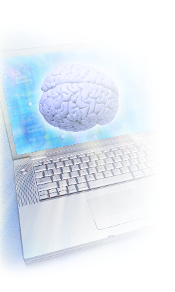
|
 |
FAQ's: Patient Treatment & Management
Below are the most common questions we receive regarding Brain Power® Patient Treatment & Management. |
|
|
What is the purpose of the "Practice" button on each task?® |
Practice mode can be used to introduce a new task to make sure that the patient understands what is required to perform the task. You can use practice mode to take your time and explain the training task. DO NOT provide actual training in practice mode as no training data is saved and the patient cannot pass a level in practice mode. |
|
|
Does the time spent in "Practice" mode count against the one hour treatment session?® |
Yes. The one hour timer is counting down whether you are using the program in "Practice" or "Training" modes, as this is all part of the treatment that is being provided. However, if the treatment session is paused, the clock is stopped until the treatment session is resumed. |
|
|
What if the patient seems to be stuck on one level and can’t pass it?® |
Patients will quickly pass levels that are within their ability. When they reach a level that they cannot pass easily, they are finally at a level that is therapeutic. Sometimes a patient may have to attempt a level 30 or more times before they can pass. This can be discouraging so it is important that you give plenty of praise and encouragement for their effort. However, when they finally pass, there is a definite sense of accomplishment and reason to celebrate. This experience teaches perseverance which we have seen carry over into school and work.
If necessary, you can go to the "Program" button on the top left side of the screen, click on "Level Parameters", and temporarily change the passing criteria on some tasks so that the level is easier to pass (although not officially). You will need to eventually set the Level Parameters back to their “default” level so that the person can officially pass the level and move on to the next level. |
|
|
What if the metronome and/or the timer bar are distracting or stressful for the patient?® |
The metronome and the timer bar are intentional distracters and do introduce an element of stress for some individuals. This is intentional for two reasons. First, performing a task at passing levels, while tuning out distracters, is another way of driving a skill to a high level of proficiency. Second, a person must be able to perform in the real world under pressure while tuning out distractions. This has actually proven to be one of the important components of the training program and what has made it so effective.
However, this can be an insurmountable problem for some people, at least temporarily. If so, you can temporarily turn down the volume of the metronome one of two ways. Within the Brain Power® program, click on “Program” in the upper left corner and then on Global Parameters. From there you can lower or raise the metronome volume. You can also turn down the audio on your computer. However, this also turns down the audio for the whole program, so this method is not recommended. Try to avoid turning the metronome off all together and return the volume to its original setting as soon as the patient has learned to tune it out.
There is not currently a way to turn off the timer bar. However, you can tape a strip of black paper across the bottom of the screen to block it from view.
Remember, the metronome and timer bar are important parts of the treatment and you should not be too quick to modify them just because the patient complains about them. Remember, “if the task is not difficult, it is not therapeutic.” |
|
|
What if the patient can’t stay on beat with the metronome?® |
Some people have a poor sense of basic rhythm. You can see this when a group of people are clapping in beat with a song and one person is clearly not on beat. If a patient can pass the accuracy criteria of a task but can’t pass the level because they can’t stay on beat with the metronome, then you may have to do some basic rhythm training.
Go to the Reference Materials page on the website and download the Rhythm Perception zip file which contains audio files for 30, 60 and 120 beats per minute. Play these files and have the patient clap in time with the metronome until they can do each speed, including clapping on every other beat, without error.
You can also train the patient on the Gross Motor Sequencing module which will also work on rhythm perception.
Once they complete these tasks they should be able to perform on beat. |
|
|
What if the patient can not do simple math in their head?® |
This can be a problem, especially when working on Divided Attention Auditory or Visual Calculation under Executive Functions. This is often due to the patient having a limited ability to create mental images or see things in their “minds eye.” This is actually a problem commonly seen in individuals with Nonverbal Learning Disabilities which affects mathematics.
Therefore, you need to work on developing the person’s mental visualization abilities. The training modules that will work on this are:
1. Spatial Visualization
2. Spatial Number Visualization
3. Spatial Figure Memory
4. Visual Spatial Picture Memory
Once these training modules have been passed at adequate levels, you can have the patient work on the Math Addition module under Academic Skills. Once the patient can do this, then they should be able to work on Divided Attention Auditory and Visual Calculation.
Also, if the patient has more global visual processing problems, you may need to also provide training on the other Visual Skills modules as well. |
|
|
What training modules should I use for Language Processing?® |
While there are only two modules actually listed under Language Processing, you will note on the Brain Power® Treatment Plan form (available on the Reference Materials page of the website) that there are several training modules in other areas that will strengthen language skills. They are as follows:
1. Spatial Visualization (processing verbal commands)
2. Spatial Number Visualization (processing verbal commands)
3. Auditory Story Memory (processing narrative verbal material)
4. Auditory and Visual Association Word Memory (conceptual processing of words to create associations)
5. Auditory and Visual Word Pairs (conceptual processing of words to create associations) |
|
|
Can Brain Power® help with Speech (Articulation) Problems? |
Actually, the Auditory Processing modules that work on phonemic processing are very effective in training articulation because the training starts with single sounds and works up to more complex multi-letter nonsense words. These modules can be used as a systematic way to train oral motor control and speech clarity. You can download the Phonemic Production zip file from the Reference Material webpage which contains the individual letter sounds. |
|
|
Do I need to do the Phonemic Processing modules I-XIII in order?® |
Yes, you should do them in order, although it is not necessary to complete every level of one module before moving on to the next one. The main thing is to realize is that the levels build on one another in terms of auditory processing complexity. You should also not train on the other auditory processing modules, such as Phonemic Blending and Segmenting, until the patient has reasonably completed Phonemic Processing V or VI which is needed to support these tasks. |
|
|
Other than the Phonemic Processing modules, are there any other training modules which must be done in a certain order? |
The other training modules can be done in any order except Deductive Reasoning. The patient should be able to complete Level 5 of Conceptual Reasoning in order to have an adequate understanding of the conceptual matches that will be used in Deductive Reasoning. |
|
|
What if I am having a hard time demonstrating the harder levels of Fine Motor Sequencing for the patient? |
Fortunately, for those of us who are “motorically challenged”, the program provides the demonstration for you in Practice mode. Check it out! |
|
|
How long does it usually take to complete the Trainer Orientation? |
A professional trainer, who needs to understand the use of the entire program, will generally require approximately 2-4 hours to review the material and practice with the program in Demonstration mode. A Support Trainer really only needs to complete those portions of the Trainer Orientation that pertain to the parts of the program they will be using with the patient. Typically, this should require no more than 2 hours. |
|
|
How do I know that a Support Trainer is ready to train? |
You may want to meet with the Support Trainer after they have completed the Trainer Orientation and checked off the attestation box, in order to discuss any questions they may have. You may also want to have them perform their first training session with the patient at your office with you present, focusing on those training tasks that the Support Trainer may be feeling unsure of. At any time you have a concern about a Support Trainer’s understanding of how to appropriately perform training, we recommend that you have them conduct a training session at your office with you present. |
|
|
How often should I meet with a Support Trainer? |
This is dependent on how much guidance the Support Trainer requires. It could be as frequent as once a week. However, if they are truly able to handle the training independently, then we recommend follow-up meetings once a month to review the patient’s progress and to make appropriate modifications to the patient’s treatment plan. |
|
|
How do I review a patient’s treatment progress? |
1. Treatment Overview. Start the Brain Power® program and open the Patient’s training account. You will need to be assigned as one of the patient’s Trainers for the patient’s name to appear on the drop down list when you log in. You can then look at the Overview screen to see how the patient is progressing through each of the training modules. Use this screen see if there is a level of a module that the patient is getting stuck on so you can discuss this at a follow up meeting. You can also see if all levels of a module have been completed as you may want to add a new module to the treatment plan.
2. Training Session Report. This report is useful to make sure that training is occurring on a consistent basis. Go to the website, "Administration", "Training Sessions". Find the patient’s name from the "Patient User Name" drop down list. Click "Generate Report" and you will see a Session Purchase and Utilization Report which will show the first and most recent date of training, and the total number of sessions conducted between those dates. You can further refine this report by limiting it to only one trainer and/or range of dates that training occurred.
3. Patient Training Sessions. Go to the website, "Administration", "Patients", click on the patient’s user name which takes you to the "Edit Patient" screen, then click on "Training" in the upper right corner. This screen is best used to look at the patient’s progress on a specific training module. You will be able to see how many sessions were spent on the module, how many attempts were made on each level and whether the level was passed or not. This data can be downloaded as an Excel file for statistical analysis in SPSS of another statistical package. |
|
|
|
